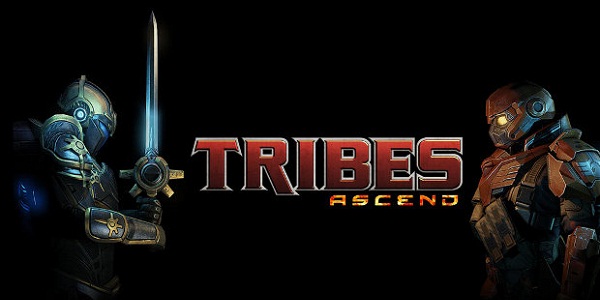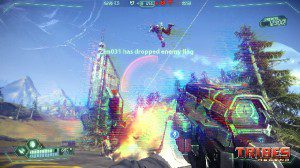It’s like a classic joust in the days of knights and kings.
You skim across the valley floor at 120 kph. High above you, an airborne ally gets hit in the chest by a microscopic sun, sending bits of his armor showering down, and bits of him… best not think about it. Ahead, a flash of light. You see the reflection half a second before the explosive blue disk hums close enough to your head for you to write your name on it. That Blood Eagle bastard is headed straight for you, claiming this crack of earth as his own.
Your assault rifle bursts to life, only a handful of rounds finding their target. Before you can even reload, you and your target have passed each other. You spin, easing to the right to ramp up from a small mound. Your jetpack ignites, teaming up with your momentum to launch you dozens of feet into the air; your dancing partner has done the same. Two more spinfusor disks buzz by you, one of them hitting what’s left of a tree struggling to grow on the edge of the mountain wall. You can’t get a steady shot while you’re both in mid-air, so you switch to your grenade launcher. His shadow and his speed give away where his landing area probably will be, and roll the dice. His toes barely touch dirt before your grenade throws him against a boulder. His momentum is gone, his jetpack is still recharging, and you reload. You land a little rougher than you’d like, but it doesn’t matter much because you just got ran over from behind by a grav cycle.
Thankfully, the respawn timer keeps you away from the mayhem for only a few seconds.
[youtube id=”O-70Bg2zRsg” (eg. Wq4Y7ztznKc) width=”600″ height=”350″]
THE BASICS
Tribes: Ascend is a highly kinetic multiplayer shooter developed by Hi-Rez Studios for PC. This entry into the series begun by Sierra Entertainment in 1998 is free-to-play, with the game client and some initial content being free while offering additional equipment, character classes, and cosmetic upgrades for purchase.
Two teams struggle for dominance on expansive maps over flags, kills, capture points, more kills, energy generators, and orbital death lasers. The currently available standard game types are Deathmatch (team or solo), Capture the Flag, Capture and Hold, and Arena. To facilitate this mayhem, players choose from nine character classes, divided into light (Pathfinder, Sentinel, Infiltrator), medium (Soldier, Technician, Raider), and heavy (Juggernaut, Doombringer, Brute). When you first register your account, you receive the Pathfinder, Soldier, and Juggernaut classes for free, with the others on the bench hoping you find them worthy of your real life money or your real life time.
And, of course, Tribes‘ signature game engine quirk-turned feature ‘skiing’ returns, and actually has two separate tutorial scenarios dedicated to it.
THE ECONOMY
There are two ways to unlock the other six classes, and optional weapons and gear for all classes, and those are GP (Gold Points) and XP (Experience Points). GP is acquired only by spending real life money on points bundles that range from $10 to $50. XP is earned by actually playing the game, and is awarded at the end of a match with bonuses based on your personal and your team’s performance. The only things that are ONLY available through spending GP are the cosmetic skins being released alongside the class-themed content patches being released regularly. At the time of this writing, there are two additional skins each for Infiltrator and Raider.
An important aspect of this system is that GP provides strictly a horizontal benefit, never a vertical one. It gives you more things, but it can’t make the things you have better. Only XP can be spent on the linear unlock path for your individual pieces of gear.
It is worth noting that there is no standard conversion between XP and GP in the prices of unlockable items. To unlock character classes, 1 GP can be ‘worth’ between 45 and 64 XP. The MIRV Launcher for the Juggernaut class, however, will set you back 780 GP or a hefty 100,000 XP, which comes to an exchange rate of slightly more than 128 XP per GP. Most weapon and gear unlocks stick closer to the class unlock rate, though it’s fairly easy to tell which things Hi-Rez are trying to enforce a bit of rarity on.
A side benefit to purchasing GP is that your account permanently gains VIP status, which confers a 50% bonus to all of your XP gains. Even if you don’t want to invest any real money upfront, it only takes a couple matches to start being able to afford upgrades for the starting classes and you can also get enough GP to unlock a new class for yourself for free just by ‘liking’ the Facebook page.
As of now, my largest complaint with the economics of the game is selection. There are multiple categories for many classes that have no alternate items to unlock and switch to, and many more provide only one choice. Currently, Hi-Rez is releasing periodic updates that focus on a single class, at the time of this writing being ‘Cloak & Dagger’ for Infiltrators and ‘Raid & Pillage’ for the Raider class. These updates include alternate skins along with new weapons and gear, and it feels like those classes that have updates have a subtle but real advantage over others simply due to more available tools.

THE GAMEPLAY
There are currently four official game modes for Tribes: Ascend: Deathmatch, Capture the Flag, Capture and Hold, and Arena. Most people will be familiar with the first two. Capture and Hold is a mode in which there are five capture points scattered across the map, and defending one for you team accrues points, and the first team to 400 points wins the match. Arena is like a smaller scale deathmatch (5 players per team) and is played on a significantly smaller map, resulting in an even faster and more brutal contest than normal.
Tribes: Ascend is essentially testing two skills: ‘can you hit this with your gun?’ and ‘can you be where you need to be?’ The first sounds pretty standard for a shooter (sorry if that’s a spoiler), but plays out a little differently than you’d expect. The second is deceptively integral to all games – even if you don’t normally think about it that way – and its importance is amplified here.
One of the very first things you notice in your first match is that it is hard to hit someone in this game. Before you’re used to the game mechanics and accustomed to each weapon individually, rounds that find the intended (or any) target are few and far between. There’s a reason that the first unlockable upgrade for every single weapon is a sizable ammo load increase. In your first few matches, the number of times you run out of ammo without claiming a kill can be daunting and make you feel like less of a warrior.
Why is it so hard to hit things? Physics, sir. The things you’re trying hit are very small and (probably) very fast. And the things you’re shooting those things with use projectiles, and projectiles use math.
Nearly all of the weapons require you to factor in projectile travel time, and the projectiles you fire also react based on your personal momentum and angle when you pull the trigger. Generally, a projectile will preserve half of the movement speed that you had when you fired it. If you shot directly forward while using your jump pack to travel straight up at 50 kilometers per hour, your projectile would travel forward at whatever speed that projectile travels at, as well as up at 25 kph, producing an effectively angled shot. Theoretically, if you were traveling at 600 kph (probably not possible), turned around to face your trail, and fired a spinfusor disc (a Tribes standard, its version of a rocket launcher), the disc would remain motionless in space as it was shot in one direction at 300 kph (the speed of a spinfusor disc) while being pulled by your momentum in the opposite direction 300 kph (half your speed).
If you manage to pull this off, send me screenshots.
Many of the weapons in this game produce an area of effect, meaning that you aren’t trying to actually hit your target as much as you are trying to hit an area of ground or wall near enough to where your target will be to splash some of the damage onto them. Firearms like the sniper rifles, assault rifles, and submachine guns should result in direct hits, but things like spinfusors, mortars, ‘thumper’ grenade launchers, and bolt launchers are more about predicting your enemy’s movement and your projectiles speed and angle than just getting your crosshairs on a certain pixel. Luck and/or skill are rewarded by these, however, as a direct hit with one of them is practically always an instant kill.
As I said earlier, the second skill-muscle you are flexing is your positioning. By that I don’t mean standing in the right spot, as standing still in Tribes is very nearly always the incorrect play. Your positioning in this game is more a matter of ‘where are you going, and how fast are you going there?’ Being out of position is essentially as detrimental to your team as not being there at all. What good is your trigger finger if their flag carrier is halfway across the map, correctly hitting every ski spot for maximum acceleration and momentum preservation? In capture-the-flag mode specifically, being able to use the map geography to quickly gain and maintain your speed is just as important to your teams success as being able to shoot straight. Thankfully, the tutorial section allows you to free-roam all available maps, giving you as much time as you would like to practice flag runs, interceptions routes, and find spots that may be hazardous to movement, allowing you to prey upon enemies who may get caught in them.
What is not fortunate, however, is that the only tutorial section designed to give you combat training provides only the most sluggish of AI opponents to annihilate, and moving from that to an actual match could make one feel like they’ve been tricked. This is, interestingly, in addition to the TWO separate tutorials dedicated to ski training.
Standard shooter fans who are used to being slaves to gravity and the meager capabilities of the non-power-armor-enhanced human body may feel a bit overwhelmed at the frantic pace as first, but Tribes: Ascend is a game that rewards dedication.
THE PRESENTATION
The graphical quality and art style of Tribes: Ascend is good, but nothing particularly stands out as fantastic.
The character models are competently designed, sporting a sort of faux-mecha motif especially on the heavier armors. Even at a lower graphics quality, the textures and character animations are attractive and well-made.
The maps are also all generally good, but not exceptional. Map-to-map differences vary wildly, with immensely different base layouts, paths for flag carrying/troop movement, common engagement zones, and defensible positions. Inside most individual maps, though, one does not often find a specific facet or idea that makes one say “wow, that’s pretty incredible.” Certainly, they were designed to be more functional than fashionable, but when I play a match on Raindance – a rather drab, dark green, rolling hill sort of place – and then one on Arx Novena – my favorite, an Ancient Rome-style map complete with navigable aqueducts and villas as bases – I can’t help but feel that sometimes the map designers brought their A game, and sometimes they were fine with their ‘good enough’ game.
FINALE
Tribes: Ascend is a good game, and you should try it. It’s free. Come on.
I will add that if you’ve tried other free to play competitive games in the past and been turned off by the type of people who seem to be the most vocal in them (the ones whose verbal abuse methods would give a court stenographer wrist cramps), then you should know that my personal experience here was mostly positive. There will always be “my team sucks!” or streams of swears in chat channels in any game, but the personal attacks here seemed minimal.
Also, you should know that ‘SHAZBOT!’ is a dirty word in the Tribes universe. That’s why you’ll hear it a hundred times a match.


